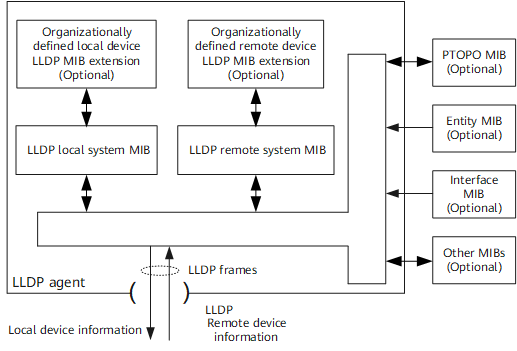LLDP Fundamentals
Implementation
LLDP must be used together with MIBs. LLDP requires that each device interface be provided with four MIBs. An LLDP local system MIB that stores status information of a local device and an LLDP remote system MIB that stores status information of neighboring devices are the most important. The status information includes the device ID, interface ID, system name, system description, interface description, device capability, and network management address.
Maintains information in the LLDP local system MIB.
Sends LLDP packets to notify neighboring devices of local device status.
Identifies and processes LLDP packets sent by neighboring devices and maintains information in the LLDP remote system MIB.
Sends LLDP alarms to the NMS when detecting changes in information stored in the LLDP local or remote MIB.
- The LLDP module maintains the LLDP local system MIB by exchanging information with the PTOPO MIB, Entity MIB, Interface MIB, and Other MIBs of the device.
- An LLDP agent sends LLDP packets carrying local device information to neighboring devices directly connected to the local device.
- An LLDP agent updates the LLDP remote system MIB after receiving LLDP packets from neighboring devices.
The NMS collects and analyzes topology information stored in LLDP local and remote system MIBs on all managed devices and determines the network topology. The information helps rapidly detect and rectify network faults.
Working Mechanism
LLDP working modes
- Tx mode: enables a device only to send LLDP packets.
- Rx mode: enables a device only to receive LLDP packets.
- Tx/Rx mode: enables a device to send and receive LLDP packets. The default working mode is Tx/Rx.
- Disabled mode: disables a device from sending or receiving LLDP packets.

When the LLDP working mode changes on an interface, the interface initializes the LLDP state machines. To prevent repeatedly initializations caused by frequent working mode changes, the NetEngine 8000 F supports an initial delay on the interface. When the working mode changes on the interface, the interface initializes the LLDP state machines after a configured delay interval elapses.
Principles for sending LLDP packets
After LLDP is enabled on a device, the device periodically sends LLDP packets to neighboring devices. If the configuration is changed on the local device, the device immediately sends LLDP packets to notify neighboring devices of the changes. If information changes frequently, set a delay for an interface to send LLDP packets. After an interface sends an LLDP packet, the interface does not send another LLDP packet until the configured delay time elapses, which reduces the number of LLDP packets to be sent.
- The fast sending mechanism allows the NetEngine 8000 F to override a pre-configured delay time and quickly advertise local information to other devices in the following situations:
- A device receives an LLDP packet sent by a transmitting device, whereas the device has no information about the transmitting device.
- LLDP is enabled on a device that previously has LLDP disabled.
- An interface on the device goes Up.
Principles for receiving LLDP packets
A device verifies TLVs carried in LLDP packets it receives. If the TLVs are valid, the device saves information about neighboring devices and sets the TTL value carried in the LLDPDU so that the information ages after the TTL expires. If the TTL value carried in a received LLDPDU is 0, the device immediately ages information about neighboring devices.
